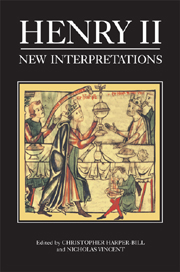Book contents
- Frontmatter
- Contents
- List of Illustrations
- Editor's Preface
- List of Abbreviations
- Introduction: Henry II and the Historians
- The Accession of Henry II
- Henry II and Louis VII
- Doing Homage to the King of France
- Henry, Duke of the Normans (1149/50–1189)
- Henry II and England's Insular Neighbours
- Henry II, the English Church and the Papacy, 1154–76
- On the Instruction of a Prince: The Upbringing of Henry, the Young King
- Henry II and the Creation of the English Common Law
- Finance and the Economy in the Reign of Henry II
- Henry II and the English Coinage
- The Court of Henry II
- Literary Culture at the Court of Henry II
- Henry II and Arthurian Legend
- Index
Henry II and the English Coinage
Published online by Cambridge University Press: 12 September 2012
- Frontmatter
- Contents
- List of Illustrations
- Editor's Preface
- List of Abbreviations
- Introduction: Henry II and the Historians
- The Accession of Henry II
- Henry II and Louis VII
- Doing Homage to the King of France
- Henry, Duke of the Normans (1149/50–1189)
- Henry II and England's Insular Neighbours
- Henry II, the English Church and the Papacy, 1154–76
- On the Instruction of a Prince: The Upbringing of Henry, the Young King
- Henry II and the Creation of the English Common Law
- Finance and the Economy in the Reign of Henry II
- Henry II and the English Coinage
- The Court of Henry II
- Literary Culture at the Court of Henry II
- Henry II and Arthurian Legend
- Index
Summary
Henry II reformed the English coinage twice, in 1158 and 1180, reorganising the mints and ordering a comprehensive replacement of the silver coins in circulation on both occasions. By the end of Henry II's reign in 1189, the number of mints in England had been severely reduced. Centralised mints replaced the dispersed small workshops of individual moneyers, which had been a normal feature of the English urban landscape since the late Anglo-Saxon period. In 1180, the moneyers lost their customary role in the administration of the profits of the coinage, and the mints now had separate exchanges, where a new kind of official paid by the king collected the profits. Henry II's second reform of the coinage, in 1180, was the prelude to an enormous growth in the size of the English currency, which began in the last years of the reign.
The principal source of documentary evidence for the English coinage in the reign of Henry II is the Exchequer's pipe rolls, which can be supplemented with Richard fitz Nigel's description of the work of the Exchequer in the Dialogus de Scaccario and information from chronicles. In 1951, Derek Allen's British Museum Catalogue (BMC) of Henry II's Cross-and-Crosslets or ‘Tealby’ coinage (see Figure 2 on p. 261), which was issued between 1158 and 1180, used the pipe rolls and other sources to construct a comprehensive analysis of the administration of the mints.
- Type
- Chapter
- Information
- Henry IINew Interpretations, pp. 257 - 277Publisher: Boydell & BrewerPrint publication year: 2007



